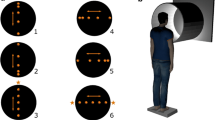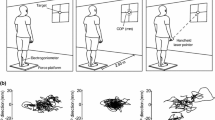Abstract
Monocular visual stabilization of fore-aft and lateral body sway was tested posturographically in normal subjects (wearing visual field blinds) as a function of visual field size and location of the visual field on the central or peripheral retina. Body sway applied to a force- measuring platform is less with central (foveal) vision when central and peripheral visual fields have the same area. If, however, the peripheral field size is corrected by the cortical magnification factor of the retina in the primary cortex, body sway is stabilized by the peripheral retina to the same extent. Thus, there is no functional specialization of central and peripheral retina with respect to balance control. Visual stabilization of upright stance is a function of field size and cortical representation of the retina. The central and the peripheral retina have different thresholds to detect motion; this was surprisingly not reflected in measurements of normal fore-aft and lateral body sway.
Similar content being viewed by others
References
Amblard B, Carblanc A (1980) Role of foveal and peripheral visual information in maintenance of postural equilibrium in man. Percept Mot Skills 51:903–912
Amblard B, Cremieux J, Marchand AR, Carblanc A (1985) Lateral orientation and stabilization of human stance: static versus dynamic visual cues. Exp Brain Res 61:21–37
Barbur JL, Ruddock KH, Waterfield VA (1980) Human visual responses in the absence of the geniculo-calcarine projection. Brain 103:905–928
Bles W, Kapteyn TS, Brandt T, Arnold F (1980) The mechanism of physiological height vertigo. II. Posturography. Acta Otolaryngol 89:534–540
Boulton JC (1987) Two mechanisms for the detection of slow motion. J Opt Soc Am 4:1634–1642
Brandt T, Dichgans J, König E (1973) Differential effects of central versus peripheral vision on egocentric and exocentric motion perception. Exp Brain Res 16:476–491
Brandt T, Krafczyk S, Malsbenden I (1981) Postural imbalance with head extension: improvement by training as a model for ataxia therapy. Ann NY Acad Sci 374:636–649
Brandt T, Paulus W, Straube A (1986) Vision and posture. In: Bles W, Brandt T (eds) Disorders of posture and gait. Elsevier, Amsterdam, pp 157–175
Cowey A, Rolls ET (1974) Human cortical magnification factor and its relation to visual acuity. Exp Brain Res 21:447–454
Dichgans J, Brandt T (1978) Visual-vestibular interaction: effects on self-motion perception and postural control. In: Held R, Leibowitz HW, Teuber H-L (eds) Handbook of sensory physiology, vol 8, Perception. Springer, Berlin Heidelberg New York, pp 755–804
Edwards AS (1946) Body sway and vision. J Exp Psychol 36:526–535
Fendrich R, Wessinger CM, Gazzangia MS (1992) Residual vision in a scotoma: implications for blindsight. Science 258:1489–1491
Grüsser O-J, Pause M, Schreiter U (1990a) Localisation and responses of neurons in the parieto-insular vestibular cortex of awake monkeys (Macaca fascicularis). J Physiol (Lond) 430:537–557
Grüsser O-J, Pause M, Schreiter U (1990b) Vestibular neurons in the parieto-insular cortex of monkeys (Macaca fascicularis). J Physiol (Lond) 430:559–583
Held R, Dichgans J, Bauer J (1975) Characteristics of moving visual scenes influencing spatial orientation. Vision Res 15:357–365
Johnston A, Wright MJ (1986) Matching velocity in central and peripheral vision. Vision Res 26:1099–1109
Kapteyn TS, Bles W, Brandt T, Wist ER (1979) Visual stabilization of posture: effect of light intensity and stroboscopic surround illumination. Agressologie 20C:191–192
Mirka A, Brookhardt JM (1981) Role of primary visual cortex in canine postural control. J Neurophysiol 46:987–1003
Newsome WT, Mikami A, Wurtz RH (1986) Motion selectivity in macaque visual cortex: III. Psychophysics and physiology of apparent motion. J Neurophysiol 55:1340–1357
Paulus W, Straube A, Brandt T (1984) Visual stabilization of posture. Physiological stimulus characteristics and clinical aspects. Brain 107:1143–1163
Perenin MT, Ruel J, Hecaen H (1980) Residual visual capacities in a case of cortical blindness. Cortex 16:605–612
Pizzamiglio L, Antonucci G, Francia A (1984) Response of the cortically blind hemifields to a moving visual scene. Cortex 20:89–99
Pöppel E, Held R, Frost D (1973) Residual visual function after brain wounds involving the central visual pathways in man. Nature 243:295–296
Romberg MH (1846) Lehrbuch der Nervenkrankheiten des Menschen. Duncker, Berlin
Rovamo J, Virsu V (1979) An estimation and application of the human cortical magnification factor. Exp Brain Res 37:495–510
Singer W, Zihl J, Pöppel E (1977) Subcortical control of visual threshold in humans: evidence for modality specific and retinotopically organized mechanisms of selective attention. Exp Brain Res 29:173–190
Stoffregen TA (1985) Flow structure versus retinal location in the optical control of stance. J Exp Psychol: Hum Percept Perform 11:554–565
Stoffregen TA (1986) The role of optical velocity in the control of stance. Percept Psychophys 39:355–360
Straube A, Brandt T (1987) Importance of the visual and vestibular cortex for self-motion perception in man (circularvection). Hum Biol 6:211–218
Straube A, Krafczyk S, Paulus W, Brandt T (1985) Visual field and postural sway with respect to the cortical magnification factor. Pflugers Archiv 403:207
Tusa RJ, Palmer LA, Rosenquist AC (1978) The retinotopic organization of area 17 (striate cortex) in the cat. J Comp Neurol 177:213–236
Virsu V, Rovamo J, Laurinen P, Näsänen R (1982) Temporal contrast sensitivity and cortical magnification. Vision Res 22:1211–1217
Weiskrantz L, Warrington EK, Sanders MD, Marshall J (1974) Visual capacity in the hemianopic field following a restricted occipital ablation. Brain 97:709–728
Author information
Authors and Affiliations
Rights and permissions
About this article
Cite this article
Straube, A., Krafczyk, S., Paulus, W. et al. Dependence of visual stabilization of postural sway on the cortical magnification factor of restricted visual fields. Exp Brain Res 99, 501–506 (1994). https://doi.org/10.1007/BF00228986
Received:
Accepted:
Issue Date:
DOI: https://doi.org/10.1007/BF00228986




